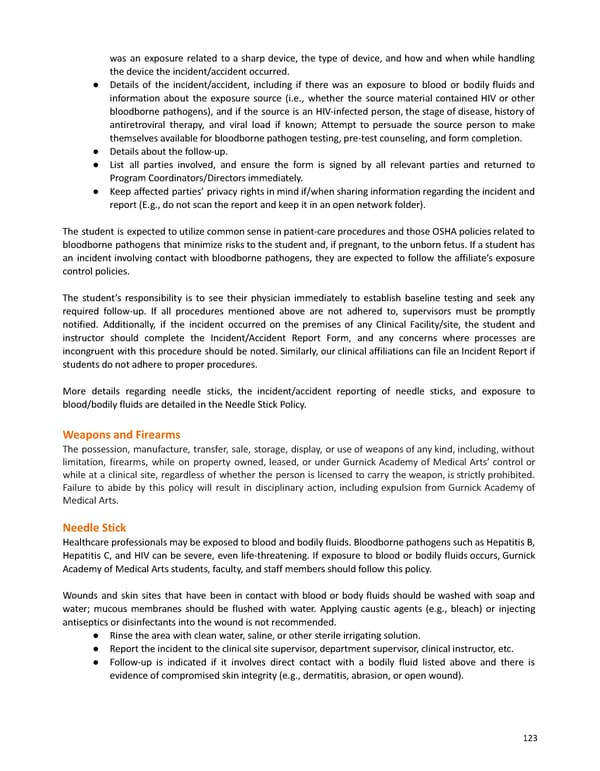was an exposure related to a sharp device, the type of device, and how and when while handling thedevicetheincident/accident occurred. ● Details of the incident/accident, including if there was an exposure to blood or bodily fluids and information about the exposure source (i.e., whether the source material contained HIV or other bloodborne pathogens), and if the source is an HIV-infected person, the stage of disease, history of antiretroviral therapy, and viral load if known; Attempt to persuade the source person to make themselvesavailable for bloodborne pathogen testing, pre-test counseling, and form completion. ● Detailsaboutthefollow-up. ● List all parties involved, and ensure the form is signed by all relevant parties and returned to ProgramCoordinators/Directors immediately. ● Keepaffected parties’ privacy rights in mind if/when sharing information regarding the incident and report (E.g., do not scan the report and keep it in an open network folder). The student is expected to utilize common sense in patient-care procedures and those OSHA policies related to bloodborne pathogens that minimize risks to the student and, if pregnant, to the unborn fetus. If a student has an incident involving contact with bloodborne pathogens, they are expected to follow the affiliate’s exposure control policies. The student’s responsibility is to see their physician immediately to establish baseline testing and seek any required follow-up. If all procedures mentioned above are not adhered to, supervisors must be promptly notified. Additionally, if the incident occurred on the premises of any Clinical Facility/site, the student and instructor should complete the Incident/Accident Report Form, and any concerns where processes are incongruent with this procedure should be noted. Similarly, our clinical affiliations can file an Incident Report if students do not adhere to proper procedures. More details regarding needle sticks, the incident/accident reporting of needle sticks, and exposure to blood/bodily fluids are detailed in the Needle Stick Policy. WeaponsandFirearms The possession, manufacture, transfer, sale, storage, display, or use of weapons of any kind, including, without limitation, firearms, while on property owned, leased, or under Gurnick Academy of Medical Arts’ control or while at a clinical site, regardless of whether the person is licensed to carry the weapon, is strictly prohibited. Failure to abide by this policy will result in disciplinary action, including expulsion from Gurnick Academy of MedicalArts. NeedleStick Healthcare professionals may be exposed to blood and bodily fluids. Bloodborne pathogens such as Hepatitis B, Hepatitis C, and HIV can be severe, even life-threatening. If exposure to blood or bodily fluids occurs, Gurnick AcademyofMedicalArtsstudents,faculty,andstaffmembersshouldfollowthispolicy. Wounds and skin sites that have been in contact with blood or body fluids should be washed with soap and water; mucous membranes should be flushed with water. Applying caustic agents (e.g., bleach) or injecting antiseptics or disinfectants into the wound is not recommended. ● Rinsetheareawithcleanwater,saline,orothersterileirrigatingsolution. ● Reporttheincidenttotheclinicalsitesupervisor,departmentsupervisor,clinical instructor, etc. ● Follow-up is indicated if it involves direct contact with a bodily fluid listed above and there is evidenceofcompromisedskinintegrity(e.g.,dermatitis, abrasion, or open wound). 123
 2023-2024 | Catalog Page 122 Page 124
2023-2024 | Catalog Page 122 Page 124